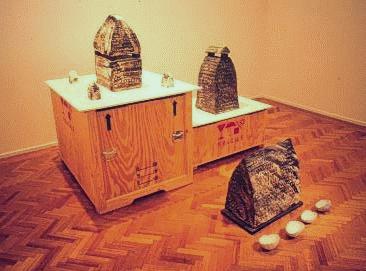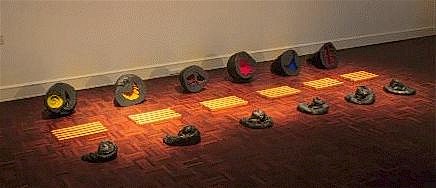|
| |
 |
The ceramist |
 |
What did the ceramist say to the baker?
 |
In English Bread a Yeast Cookery, Elizabeth David writes that bakers have
traditionally resented potters: though they were necessary to build ovens and make special
moulds, all too often they lived in a world of their own unable to respond quickly to
requests. She writes, `Potters do what they please, and when, and what suits their kilns
and their firing routine.' Undercutting this history of conflict is the evidence of shared
experience working a plastic material that must undergo the ordeal of fire before it is
ready to venture out into the world. |
| A Lebanese woman making mountain bread in a Melbourne
bakery. |
| Neville Assad (Furren-El-Shibbeck: Observations to an internal space)
draws on the juxtaposition of kiln and oven in the Middle Eastern village to offer
testament to the hands that serve both. His clay pieces represent the three elements
shared by pottery and breadmaking: earth, water, and fire. |
 |
 |
Rod Bamford (Dividing line) provides a more conceptual visual grammar for
linking craft and trade. The front row contains pieces showing the developing of a clay
form using the Ram's Head technique. The middle row consists of terracotta strips with DNA
codes stamped on them. The back row shows clay forms with negative impression of final
objects: croissant, tea cup, loaf of bread, etc. |
Now let's hear from the other side
|


